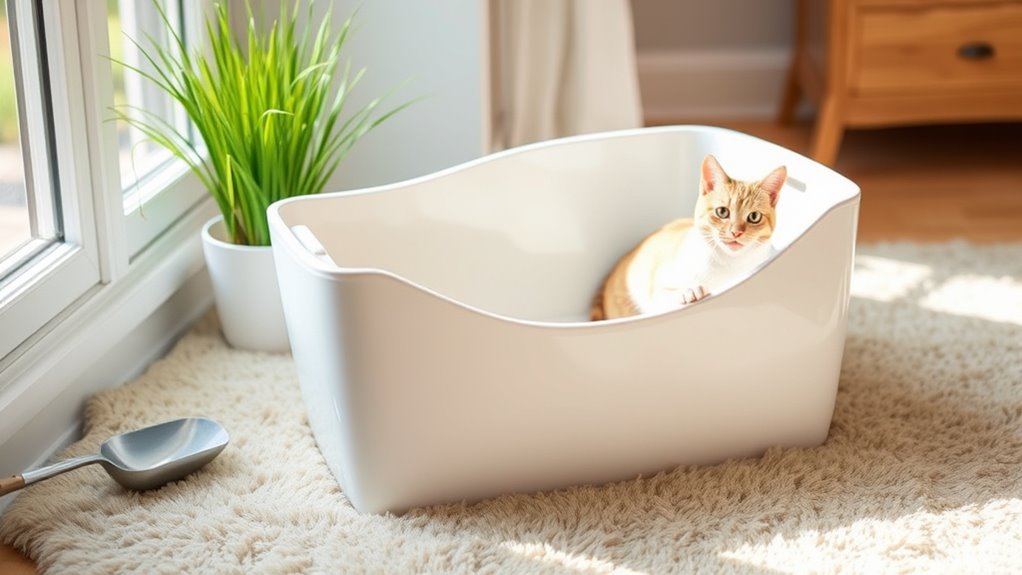To keep your cats happy, place the litter box in a quiet, easily accessible spot away from food and water areas. Choose a size and style they’re comfortable with, and use a litter type they prefer. Scoop it regularly, clean it thoroughly each week, and guarantee good ventilation. Adding extra boxes for multiple cats and maintaining privacy helps prevent stress. Learn more tips to create the perfect setup for your feline friends.
Key Takeaways
- Place the litter box in a quiet, accessible area away from food and water to reduce stress and encourage use.
- Choose a spacious, easy-to-enter litter box with your preferred design—open or covered—for comfort and odor control.
- Use high-quality, unscented, or natural clumping litter, maintaining the correct depth for hygiene and ease of cleaning.
- Clean the box weekly and scoop waste frequently to prevent odors and promote a hygienic environment.
- Provide multiple litter boxes in different quiet locations, especially for multiple cats, to prevent territorial disputes and accidents.
Choose the Right Location for the Litter Box
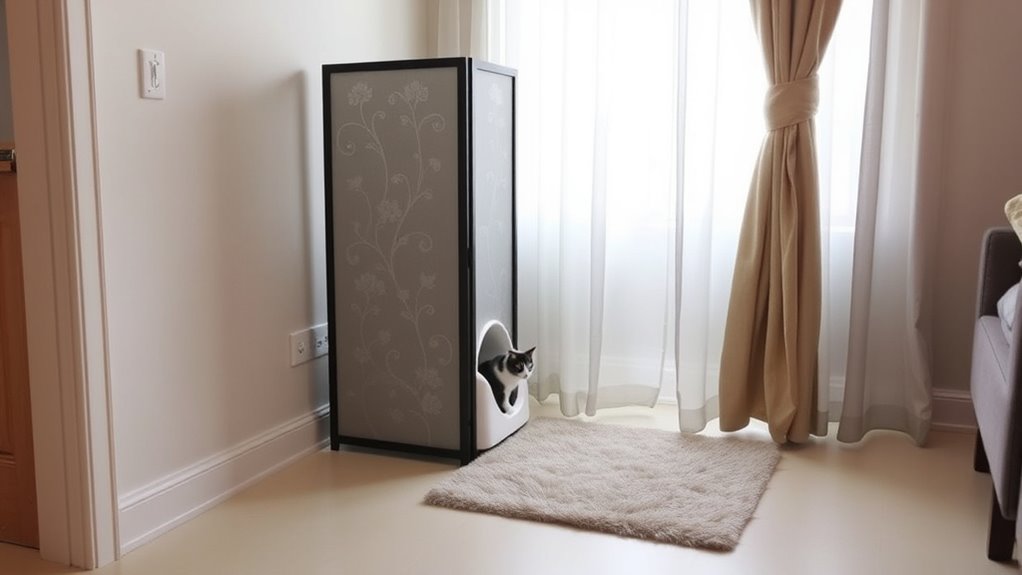
Choosing the right spot for your cat’s litter box is essential to guarantee they feel comfortable and are more likely to use it consistently. A good location promotes proper litter box hygiene and aligns with your cat’s natural behavior. Place the box in a quiet, low-traffic area where your cat can relax without feeling exposed or cornered. Avoid placing it near their food and water bowls, as cats prefer separation between eating and elimination spots. Cleanliness is key; a clean, well-placed litter box encourages regular use and reduces accidents. If the box is too hidden or in an uncomfortable spot, your cat might avoid it, leading to undesirable behavior. Proper placement helps maintain hygiene and supports your cat’s instinctual needs, making both of you happier. Understanding cat behavior can help you choose the optimal location that respects their natural instincts and promotes a healthy litter box routine.
Select the Appropriate Type of Litter Box

Choosing the right litter box involves considering the size for your cat’s comfort and whether an open or covered design suits their preferences. Easy access features can make cleanup easier and encourage consistent use. Think about what will keep your cat comfortable and happy in their space. Providing ample space and appropriate enrichment can also enhance your cat’s overall well-being in their environment.
Size Matters for Comfort
Because a litter box that’s too small can make your cat uncomfortable and discourage them from using it, selecting the right size is essential for their comfort. A spacious litter box allows your cat to move freely and dig without restrictions, promoting proper use. When choosing a size, consider your cat’s size and habits, ensuring there’s enough room for them to turn around comfortably. Proper litter box placement is also vital; place it in a quiet, accessible area to reduce stress. Additionally, using effective odor control techniques—like regular cleaning and good ventilation—helps keep the area fresh, encouraging consistent use. A suitably sized litter box combined with thoughtful placement and odor management creates a welcoming environment that keeps your cat happy and healthy.
Covered vs. Open Designs
Are you wondering whether a covered or open litter box suits your cat best? The choice impacts litter box aesthetics and how well it fits your space. Covered boxes provide privacy and help contain odors, making them a good fit if you prefer a cleaner look. They also offer design compatibility with modern or minimalist decor. However, some cats may feel trapped or avoid covered options altogether. Open litter boxes are simple, easy to clean, and often preferred by cats that dislike enclosed spaces. They blend seamlessly into most environments and give your cat easy access. Consider your cat’s preferences and your space when choosing between the two. The right choice ensures your cat feels comfortable and your setup remains visually appealing. Additionally, litter box design can influence your cat’s comfort and your home’s overall look.
Easy Access Features
Selecting a litter box with easy access features guarantees your cat can use it comfortably and without frustration. For cats with mobility issues or older cats, consider low-sided or open designs that allow effortless entry and exit. These options also fit better with various litter box aesthetics, blending seamlessly into your home. Understanding your cat’s behavioral habits helps determine the best style—some cats prefer privacy, while others like easy, quick access. Avoid high-sided or covered boxes if your feline shows signs of discomfort or reluctance to use the box. Easy access features promote regular use and help prevent accidents around the house. By choosing a litter box tailored to your cat’s needs, you support their comfort and health, making litter box maintenance simpler for you as well. Proper design ensures your cat’s needs are met and encourages consistent use.
Use the Best Litter Material for Your Cat
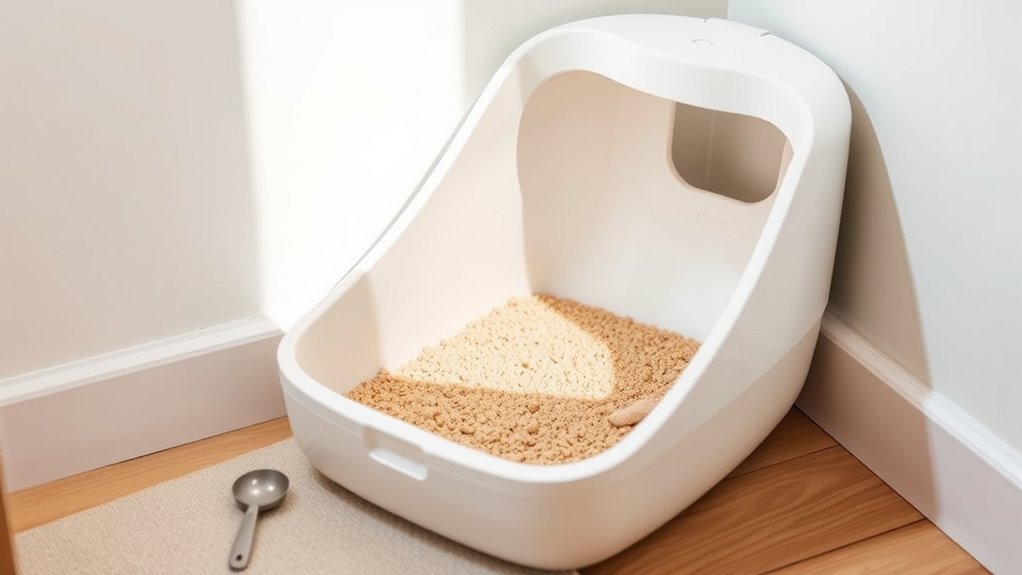
Choosing the right litter material can make a big difference in your cat’s happiness. You’ll want to contemplate options like clumping versus non-clumping, scented versus unscented, and natural versus synthetic. Picking the best fit helps keep your cat comfortable and your litter box clean. Additionally, selecting a litter with effective odor neutralization can significantly improve your indoor air quality and overall environment.
Clumping vs. Non-Clumping
When it comes to litter, understanding the difference between clumping and non-clumping varieties can make a big impact on your cat’s comfort and your cleaning routine. Clumping litter forms solid blocks around waste, making it easier to scoop and control odor. Non-clumping litter absorbs moisture but doesn’t form firm clumps, which may require more frequent changes. Your choice depends on your preferences for maintenance and odor control options. Consider this comparison:
| Feature | Clumping Litter | Non-Clumping Litter | Best Use Cases |
|---|---|---|---|
| Litter box materials | Bentonite clay, silica gel | Clay, recycled paper | Easy scooping, odor control |
| Odor control options | Superior odor lock | Less effective | Long-term freshness |
| Maintenance | Less frequent scooping | More frequent cleaning | Convenience for busy owners |
| Price | Generally higher | Usually cheaper | Budget-friendly options |
Additionally, choosing the right type of litter can depend on your cat’s preferences and your household needs, which can influence overall litter box hygiene.
Scented vs. Unscented
Scented and unscented litter each offer distinct benefits, so understanding your cat’s preferences and sensitivities can help you decide which is best. Scented vs. unscented litter impacts odor control and your cat’s comfort. Scented litter masks odors with fragrances, making the area smell fresher but potentially irritating sensitive noses. Unscented litter relies on natural odor control, which some cats prefer for its neutrality and fewer chemicals. Consider these points:
- If your cat is sensitive or easily irritated, unscented litter minimizes discomfort.
- For strong odor control, scented litter can be more effective if your space lacks ventilation.
- Your choice can influence your cat’s willingness to use the box consistently, affecting overall cleanliness.
Choosing the right type guarantees a happier, healthier litter experience for your feline friend.
Natural vs. Synthetic
The type of litter material you select can considerably influence your cat’s comfort and your home’s odor control. Natural litters, like wood, paper, or corn, are eco-friendly and often more absorbent, reducing smell and dust. Synthetic options, such as silica gel, last longer and require less frequent changing. When considering litter box placement, choose a quiet, private spot that’s easy to access. Using the right litter box accessories, like liners or mats, can make cleaning easier and help contain messes. Natural litters tend to be softer, which cats prefer, but they may track more. Synthetic litters might last longer but can sometimes be less appealing to sensitive cats. Choose the best material based on your cat’s preferences, lifestyle, and your cleaning routine. Additionally, understanding shower options can help you create a comfortable space for your pet and yourself, especially if you’re considering a modern upgrade.
Maintain Proper Litter Depth
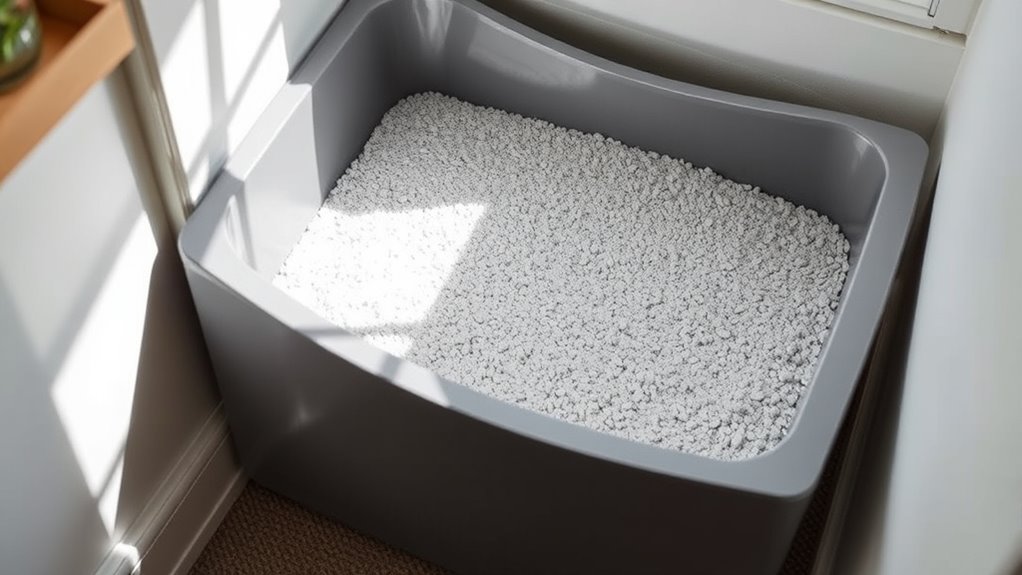
Maintaining the right litter depth is essential for your cat’s comfort and hygiene. If the litter is too shallow, your cat might kick it out or struggle to dig, leading to mess and frustration. If it’s too deep, it can cause discomfort and discourage use. To guarantee your cat stays happy and healthy, follow a consistent maintenance routine. A proper litter depth keeps your cat comfortable and promotes good hygiene habits. Proper maintenance practices are important for ensuring the longevity and effectiveness of your litter box setup.
Keep the Litter Box Clean and Odor-Free
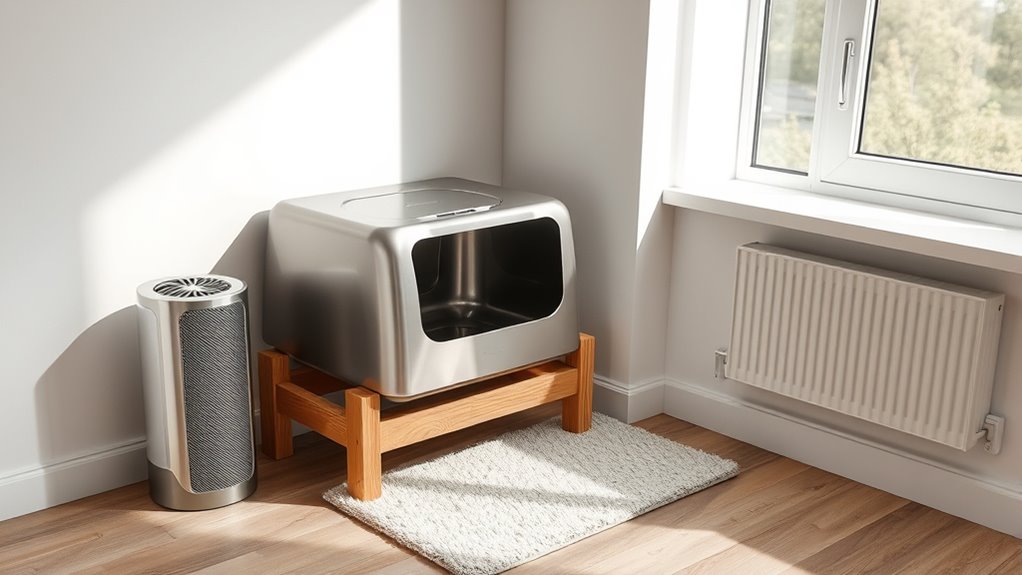
To keep your cat happy and healthy, it’s essential to keep the litter box clean and odor-free. Start by choosing the right litter box materials—plastic is common, but guarantee it’s easy to clean and free of cracks. Regular scooping removes waste that causes odor and discourages litter box avoidance. To enhance odor control techniques, consider using clumping litter, which makes cleaning easier and traps odors effectively. You can also sprinkle a layer of baking soda at the bottom of the box to absorb smells. Cleaning the entire box with mild soap and water weekly helps prevent bacteria buildup. Proper maintenance ensures your cat’s space stays fresh and inviting, encouraging good litter box habits and overall health. Incorporating proper ventilation can also help reduce lingering odors and maintain a fresh environment for your feline friend.
Provide Adequate Ventilation and Privacy
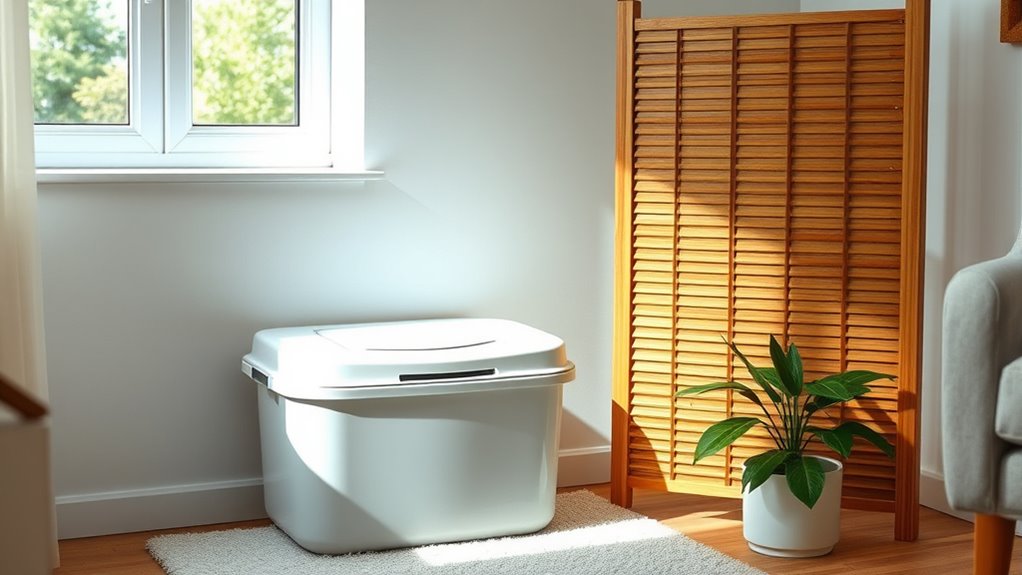
Ensuring proper ventilation and privacy for your cat’s litter box not only helps control odors but also encourages consistent usage. Good ventilation options, like a well-placed window or an exhaust fan, keep the area fresh and odor-free. Privacy considerations are equally important; your cat needs a quiet, secluded spot to feel secure. Proper placement can also prevent your cat from associating the litter box with stress-inducing noise or disturbances. Consider these key points:
- Choose a location with adequate airflow to prevent lingering smells.
- Pick a private, low-traffic area where your cat won’t feel exposed.
- Use a covered box or a privacy screen if needed to enhance comfort.
Avoid Placing the Litter Box Near Food and Water

Placing the litter box too close to your cat’s food and water bowls can lead to unwanted behaviors and health issues. Cats may associate their food and water with the smell of waste, which can reduce their appetite and affect food safety. Poor water quality might occur if litter particles or waste fumes contaminate their drinking area. Keeping the litter box separate helps guarantee your cat maintains good hygiene and stays comfortable. It also minimizes the risk of bacteria spreading from the litter to their food and water sources. By choosing a different location, you help promote better water quality and encourage healthy eating habits. Additionally, electric dirt bikes can reach speeds of up to 50 mph, making proper placement of their living and activity spaces even more important. Remember, a clean, odor-free zone away from food areas supports your cat’s overall well-being and happiness.
Consider Multiple Boxes for Multiple Cats
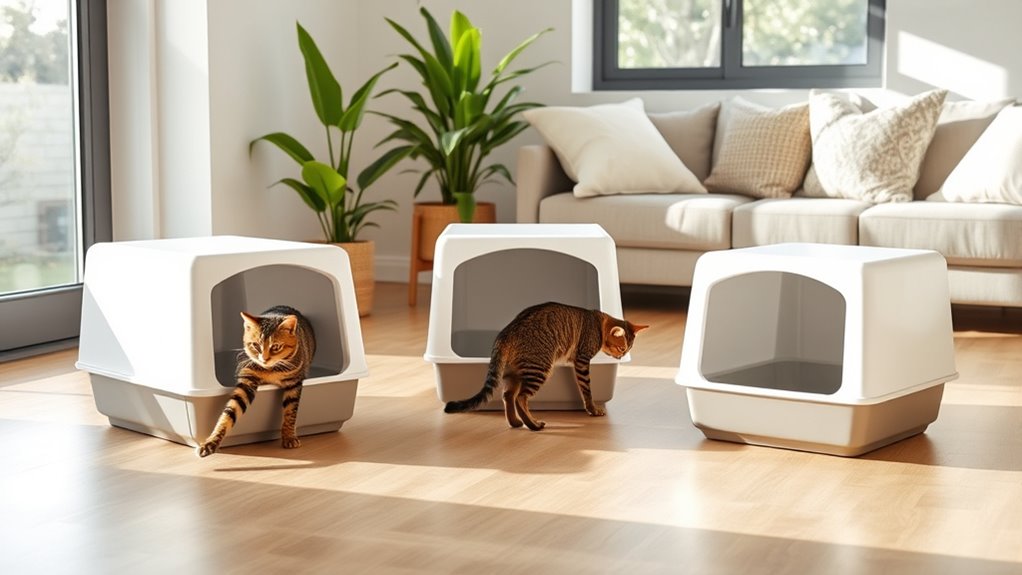
If you have multiple cats, providing more than one litter box is essential to prevent territorial disputes and reduce mess. Multi-cat households often face issues with litter box sharing, which can lead to stress and accidents. To guarantee harmony, consider these tips:
Multiple litter boxes prevent conflicts and mess in multi-cat homes.
- Place each box in a different, quiet area to give your cats personal space and avoid conflicts.
- Keep boxes accessible and upright, encouraging your cats to use them without hesitation.
- Use the right number of boxes—at least one per cat plus one extra—to promote comfort and reduce competition.
- The increased interest in alternative investments like gold IRAs underscores the importance of providing a secure and stress-free environment for your cats.
Make the Litter Box Easily Accessible and Safe

Making sure your cats can easily access their litter boxes is key to encouraging consistent use and preventing accidents. Confirm the litter box height is appropriate—too high, and your cat may struggle; too low, and it might be unsafe or prone to spills. A box that’s easy to enter and exit helps especially for older or arthritic cats. Also, consider odor control options to keep the area fresh and inviting. Using covered boxes with good ventilation or adding odor-absorbing materials can make a big difference. Place the litter box in a safe, quiet spot away from high-traffic areas but still accessible. Regularly check that nothing obstructs your cat’s way, and keep the area clean to promote happy, healthy litter box habits.
Frequently Asked Questions
How Often Should I Completely Change the Litter in the Box?
You should completely change the litter in the box every 1 to 2 weeks to maintain proper litter box maintenance and support your cat’s hygiene. Regularly scooping out waste daily helps keep the box clean and odor-free. By revitalizing the litter regularly, you guarantee your cat stays healthy and comfortable, and you prevent unpleasant odors. Consistent litter changes are key to promoting good hygiene and a happy, stress-free environment for your feline friend.
Can Certain Litter Types Cause Allergies in Cats or Humans?
Certain litter types can cause allergies in both cats and humans, especially those with strong fragrances or dust. If you notice sneezing, itching, or respiratory issues, consider switching to hypoallergenic options like natural, unscented litters. Always observe your cat’s reactions and consult your vet if allergies persist. Choosing the right litter reduces litter allergies and keeps both you and your feline happy and healthy.
How Do I Prevent My Cat From Scratching or Digging Outside the Box?
To prevent your cat from scratching or digging outside the box, guarantee the litter box is clean and spacious enough. Use a deep litter box with high sides to discourage litter digging, and consider adding a mat or a litter box liner that minimizes mess. Providing scratching posts nearby also helps redirect cat scratching behavior. Regularly clean the area around the box to reduce the urge to scratch or dig outside it.
What Are the Signs of a Litter Box That’s Not Suitable for My Cat?
If your cat avoids the litter box or scratches around it excessively, the box might not suit them. Watch for persistent litter box odor, which indicates it’s not cleaning well or is too small. Your cat’s scratching outside the box could signal discomfort or that they’re trying to hide messes. Consider a larger, cleaner box, and verify it’s in a quiet, accessible spot to encourage proper use.
How Can I Encourage a Cat to Use a New Litter Box?
Imagine your cat sniffing a new litter box, hesitant yet curious. To encourage use, observe their litter box preferences—texture, depth, and location—and match these. Keep it clean and inviting, placing it in a quiet, accessible spot. Gradually introduce the new box alongside the old, allowing your feline to adapt at their own pace. Consistency and patience will help establish healthy feline bathroom habits and make the progression smooth.
Conclusion
By setting up your litter box thoughtfully, you’re creating a sanctuary where your cat feels safe and comfortable—like a cozy corner in their own kingdom. Keep it clean, private, and inviting, and your feline friend will return happily every time. Remember, a well-placed litter box is the foundation of a happy cat and a harmonious home. With these tips, you’ll turn litter box duty into a breeze, ensuring your kitty’s happiness and your peace of mind.
